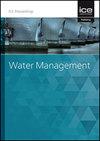堰结构的多目标优化设计
IF 0.9
4区 工程技术
Q3 ENGINEERING, CIVIL
Proceedings of the Institution of Civil Engineers-Water Management
Pub Date : 2023-04-20
DOI:10.1680/jwama.22.00002
引用次数: 0
摘要
导流头工程,也称为堰或拦河坝,是在河流或运河上建造的建筑物,用于储存水或提高水位。导流堰结构的设计包括水平围堰、倾斜围堰和板桩截流的深度、长度和厚度参数的计算。导流堰结构的设计参数具有复杂的非线性关系,传统上使用经验推导的建议和迭代来确定结构的稳定性,以防止冲刷、隆起、滑动、管道和倾覆造成的破坏。然而,当前的设计方法并没有明确地探索许多相关设计目标之间的权衡;未能揭示可能更好的设计。本文提出了导流堰结构的多目标优化设计方法。本文还提供了一个免费的开源代码,可以用作设计工具。该方法在一个风格化设计问题上得到了验证。结果表明,该方法揭示了稳定性指标与成本平衡不同的解决方案;根据板桩与围护层材料的相对造价,各构件参数值的最优关系也不同。1.重点目前透水介质导流结构的设计方法没有探索许多相关设计目标之间的权衡,未能揭示可能的优越设计2。提出了导流堰结构多目标优化设计公式。3所示。多目标优化使得结构的稳定性和成本都有了很大的提高。本文章由计算机程序翻译,如有差异,请以英文原文为准。
Optimised multi-objective design of weir structures
Diversion head works, also called weirs or barrages, are structures constructed across rivers or canals to store water or raise water level. The design of diversion weir structures involves calculating the depth, length and thickness parameters of the horizontal and sloping aprons and sheet pile cut-offs. The design parameters of a diversion weir structure, which have complex non-linear relationships, are determined traditionally using empirically derived recommendations and iterations to achieve structural stability against failures due to scour, uplift, sliding, piping and overturning. However, current design approaches do not explicitly explore the trade-offs between the many relevant design objectives; failing to reveal possibly superior designs. This article proposes a multi-objective optimization design approach for a diversion weir structure. The article also provides a free and open-source code that can be used as a design tool. The method is demonstrated on a stylised design problem. The results show the method reveals solutions with diverse balances of stability metrics and cost; with the optimal relationship of parameter values of components also varying based on the relative cost of sheet pile and apron construction materials. Key Points 1. Current design approaches for diversion structures on permeable media do not explore the trade-offs between the many relevant design objectives, failing to reveal possibly superior designs 2. A design formulation for multi-objective optimization of diversion weir structures is proposed. 3. Multi objective optimization achieves substantial improvement in stability of the structure and cost.
求助全文
通过发布文献求助,成功后即可免费获取论文全文。
去求助
来源期刊
CiteScore
2.10
自引率
0.00%
发文量
28
审稿时长
6-12 weeks
期刊介绍:
Water Management publishes papers on all aspects of water treatment, water supply, river, wetland and catchment management, inland waterways and urban regeneration.
Topics covered: applied fluid dynamics and water (including supply, treatment and sewerage) and river engineering; together with the increasingly important fields of wetland and catchment management, groundwater and contaminated land, waterfront development and urban regeneration. The scope also covers hydroinformatics tools, risk and uncertainty methods, as well as environmental, social and economic issues relating to sustainable development.

 求助内容:
求助内容: 应助结果提醒方式:
应助结果提醒方式:


